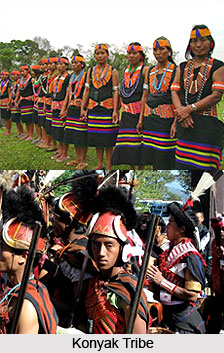 People of Mon District refer to folks of several communities, cultures, religions and customs of different hues who inordinately intermingle freely in Mon district to constitute a homogeneous blend. Mon District was not brought under the Civil Administration till the year 1948. By the year 1914, the Foreign and Political Department of Government of India, extended the Assam Frontier Tract Regulation of 1880 to the Hills, which were either inhabited or frequented by Abor Tribes, Mishmi Tribe, Singpho Tribe, Naga Tribe, Khamptis, Bhutias, Akas and Daflas. It is by this extension, Government of India named the region as the North East Frontier Tract. Hence, the present Mon District was also brought under same government notification. In 1951, the plain portion of Balipara Frontier Tract, Tirap Frontier Tract, Abor Hills District and Mishmi Hills were transferred to the administrative jurisdiction of the Government of Assam. Thereafter, the remaining areas of the said North East Frontier together with the Naga Tribal Area of Tuensang including Mon District were re-named as the North East Frontier Agency. The district was carved out of the Tuensang District (Nagaland) on 21st of December, 1973.
People of Mon District refer to folks of several communities, cultures, religions and customs of different hues who inordinately intermingle freely in Mon district to constitute a homogeneous blend. Mon District was not brought under the Civil Administration till the year 1948. By the year 1914, the Foreign and Political Department of Government of India, extended the Assam Frontier Tract Regulation of 1880 to the Hills, which were either inhabited or frequented by Abor Tribes, Mishmi Tribe, Singpho Tribe, Naga Tribe, Khamptis, Bhutias, Akas and Daflas. It is by this extension, Government of India named the region as the North East Frontier Tract. Hence, the present Mon District was also brought under same government notification. In 1951, the plain portion of Balipara Frontier Tract, Tirap Frontier Tract, Abor Hills District and Mishmi Hills were transferred to the administrative jurisdiction of the Government of Assam. Thereafter, the remaining areas of the said North East Frontier together with the Naga Tribal Area of Tuensang including Mon District were re-named as the North East Frontier Agency. The district was carved out of the Tuensang District (Nagaland) on 21st of December, 1973.
The Konyaks are of Mongoloid in origin. Before the advent of Christianity into Nagaland, the Konyaks were the believers of "Animism" worshipping different objects of nature. About 95% of the population follows the Christian faith now. The Konyak society is obviously a patriarchal society and is dominated by male chauvinism. The eldest son of the family usually inherits the paternal property. The male members take all major decisions regarding the village; society etc. and women cannot partake in the discussion in the meeting. But trends are gradually changing with more liberal thinking and treating women as equal to men in all respects. The Konyaks speak different dialects in different villages. Each village has its own sub-dialect quite distinct from others. The Konyaks are hospitable in nature, warm hearted and fond of merry-making. Elderly men indulge themselves with "Khalap" which is black tea. A kettle is always left in the fireplace for boiling black tea.
Economy of Mon District
Economy of Mon District is basically agrarian. The main occupation of the people of this district is agriculture with nearly 90 per cent of the work force engaged in it. Mon District has great potentialities for economic development if the forest resources, human resources, water resources etc. can be re-generated. But the economic condition of the district lacks infrastructure inadequacies. The recent trend in the district is tea-cultivation by the local people. The gentle slopes of Mon District provide ample scope for developing cultivation in the region with all modern techniques.
Culture of Mon District
Mon District is rich in its culture and tradition. It has rich cultural heritage of ages past wooden effigy and statues dating back to Stone Age depicting the human craftsmanship and skill. The Konyaks are skilled in the art of making firearms. They are also skilled in handicrafts like basket making, cane and bamboo works, brass works etc. Konyaks celebrate mainly two festivals, namely "Aolingmonyu" and "Laolongmo" besides Christmas, New Year, etc. Aolingmonyu is celebrated in the spring season after the sowing of seeds in the month of April. Laolongmo is celebrated in the month of August after the harvest is over.
Festivals of Mon District
Festivals of Mon District at once point towards the rich cultural heritage of the people of the region. The Konyaks are skilled in the art of making firearms. They are also skilled in handicrafts like basket making, cane and bamboo works, brass works etc. Making of necklaces, wristbands, garter with beads make one gasp with wonder and pleasure.
The Konyaks celebrate mainly two festivals, namely "Aolingmonyu" and "Laolongmo" besides the Christmas, New Year etc. The Aolingmonyu is celebrated in the spring season after the sowing of seeds in the month of April. The festival is celebrated from 1st to 6th April in order to seek blessings from God "Yongwan" to have good harvest for the year. The Laolongmo is celebrated in the month of August after the harvest is over. Aolinggmonyu is the main festival of the Konyaks. It is celebrated every year in the spring season i.e. after the sowing of seeds. The festival lasts from 1st to 6th April. This festival is celebrated to ask for blessings from God "Yongwan" for a bumper harvest for the year. Young and old in traditional dresses and headgears decorated with feathers and wild boar tusks, accompanied with log drums chant folk songs and have a merry time with great feasting. Laolongmo is another important festival of the Konyaks, which is celebrated in the month of August after the harvest, is over.



















